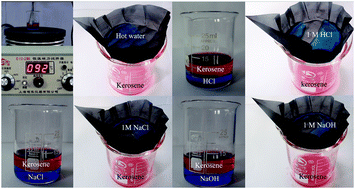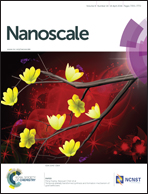Superhydrophobic meshes that can repel hot water and strong corrosive liquids used for efficient gravity-driven oil/water separation†
Abstract
Oil-polluted water has become a worldwide problem due to increasing industrial oily wastewater as well as frequent oil-spill pollution. Compared with underwater superoleophobic (water-removing) filtration membranes, superhydrophobic/superoleophilic (oil-removing) materials have advantages as they can be used for the filtration of heavy oil or the absorption of floating oil from water/oil mixtures. However, most of the superhydrophobic materials used for oil/water separation lose their superhydrophobicity when exposed to hot (e.g. >50 °C) water and strong corrosive liquids. Herein, we demonstrate superhydrophobic overlapped candle soot (CS) and silica coated meshes that can repel hot water (about 92 °C) and strong corrosive liquids, and were used for the gravity driven separation of oil–water mixtures in hot water and strong acidic, alkaline, and salty environments. To the best of our knowledge, we are unaware of any previously reported studies on the use of superhydrophobic materials for the separation of oil from hot water and corrosive aqueous media. In addition, the as-prepared robust superhydrophobic CS and silica coated meshes can separate a series of oils and organic solvents like kerosene, toluene, petroleum ether, heptane and chloroform from water with a separation efficiency larger than 99.0%. Moreover, the as-prepared coated mesh still maintained a separation efficiency above 98.5% and stable recyclability after 55 cycles of separation. The robust superhydrophobic meshes developed in this work can therefore be practically used as a highly efficient filtration membrane for the separation of oil from harsh water conditions, benefiting the environment and human health.


 Please wait while we load your content...
Please wait while we load your content...